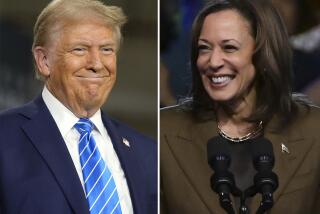GOP Seeks Governorships in Bid to Be Majority Party
WASHINGTON — In a political age dominated by the President and Congress, contests for governor have often been shunned as provincial sideshows. This year, however, gubernatorial elections in 36 states may well represent the Republican Party’s last best chance of becoming the nation’s majority party before the dawn of the next century.
Winning control of the White House and the Senate in 1980 helped the Republicans move from minority-party status into near-parity with the Democrats. Now, this year’s gubernatorial contests offer the GOP a priceless opportunity to expand its gains, partly because of the political arithmetic and partly because governors exert enormous influence over the political future of their parties.
Says Republican National Chairman Frank J. Fahrenkopf Jr., “The way to build a party is to have the governors’ chairs.”
Highly Vulnerable
The numbers give the GOP a special opportunity in 1986: Among the nation’s 50 governors, Democrats outnumber Republicans 34 to 16. That makes Democrats highly vulnerable this year because, of the 36 governorships at stake in November, Democrats hold 27--including six in the 11 most populous states. Increasing the GOP’s opportunity is the fact that 14 of the 27 Democratic incumbents are not seeking reelection.
If Republicans can seize a bundle of governorships, they stand to reap a rich harvest of benefits.
First, because the two national parties remain today what they have been throughout their history--loose federations of similarly minded citizens grouped together at the state level--most of the partisan vitality and, not incidentally, the patronage can be found there.
“Whether or not your party controls the machinery of most of the state governments affects the public perception as to whether your party is really running the country,” says Eddie Mahe Jr., a consultant to the Republican National Committee. “Even in states with weak governors, governors still appoint the other top officials and set the public agenda.”
More concretely, Republicans believe that electing governors, with their control of state government apparatus and their ability to command public attention, will help the 1988 GOP presidential standard-bearer.
Longer-term, electing more GOP governors could indirectly strengthen the party’s hand in the continuing fight for control of Congress. Republicans believe that most of the new governors they elect in 1986 will be able to gain reelection in 1990--as about 70% of incumbent state chief executives have done in recent years. This, in turn, would bolster the GOP position in the battle over legislative reapportionment that will follow the 1990 census.
And reapportionment casts a long shadow. Republicans contend that Democratic control of the post-1980 reapportionment process at the state level all but guarantees continued Democratic domination of the House of Representatives throughout this decade. The governors whom Republicans expect to elect in 1986 could help keep reapportionment history from repeating itself in the 1990s and give the GOP a crucial chance to improve its standing in Congress before the year 2000.
Important as the governors’ elections are in the national scheme of things, however, voters in most states tend to see these campaigns from a local rather than a national perspective. And this attitude, one of the political realities rooted in this country’s federal system of government, presents a serious obstacle to Republican ambitions.
Wave of Prosperity
Most states, apart from those whose economies are closely linked to agriculture or oil, now have substantial surpluses in their treasuries, making life easier for their governors, most of whom are Democrats. “There’s no ‘throw the rascal out’ mentality because the economy is healthy,” the GOP’s Fahrenkopf said.
Indeed, it is hard to find any national issue at all that overshadows the local concerns and personalities that traditionally dominate campaigns for the governorships. Said Republican political consultant John Deardourff, who is helping shape strategy for GOP gubernatorial contenders in Pennsylvania, Ohio, Illinois, Florida, Colorado and Texas: “The biggest thing these campaigns have in common is me.”
Thus, in the two big states where Republicans believe they have the best chance of unseating Democratic incumbents, the outcome is bound to be influenced mainly by local problems and by voter reaction to the campaign styles of two aging political warhorses who are the Republican nominees: 76-year-old former Gov. James A. Rhodes in Ohio and 69-year-old former Gov. Bill Clements in Texas.
In Ohio, the nation’s sixth most populous state, incumbent Democratic Gov. Richard F. Celeste takes credit for the improvement in the economy but is considered vulnerable because of his state’s 1985 savings and loan crisis and also because of allegations of misconduct against some of his appointees.
Some Republicans privately wonder whether Rhodes, who during his own past service as governor has been accused of doing too many favors for his friends, is the best choice to attack Celeste on issues of ethics and rectitude.
Eye for the Jugular
But even Democrats concede that Rhodes has a sharp eye for the political jugular. When asked his view of how Celeste handled the S&L; crisis, Rhodes replied: “He did the work of two men--Laurel and Hardy.”
Similarly, in Texas, third-biggest state in the nation, Clements’ personality is expected to be a major factor in his challenge to incumbent Democrat Mark White. Clements is trying to live down the reputation as a hothead he earned during his own stint as governor, which ended when White defeated him in 1982. On the campaign trail he is said to carry a list of 10 things to do before losing his temper--among them, thinking about fishing.
Republicans are counting on Clements’ aggressiveness to make White pay a political price for the economic hardships that have afflicted Texas since oil prices collapsed, while White will try to put the blame on economic policies of the Reagan Administration.
White will probably have a hard time making his case, according to Democratic pollster Mark Mellman, because voters tend to hold state chief executives responsible when their local economies turn sour, whatever the larger contributing causes.
But, if governors draw most of the blame for their states’ economic troubles, they also seem to get credit for good times. And that rule of thumb seems to be working out to the Democrats’ advantage in other big states where their governors are seeking reelection.
Relatively Safe
Reviving economic conditions help explain why Democrats Mario M. Cuomo in New York and Michael S. Dukakis in Massachusetts are considered relatively safe and James J. Blanchard in Michigan is well ahead. In Florida, the other big-state governorship that Democrats are defending, Republicans have a better chance because incumbent Bob Graham is running for the Senate and six Democrats are vying for the party’s nomination to replace him.
Republicans have three big-state governorships of their own at stake. The GOP is confident in California, where George Deukmejian is leading Democratic Mayor Tom Bradley of Los Angeles in the polls, and in Illinois, where Democrat Adlai E. Stevenson III’s challenge to incumbent James R. Thompson has been disrupted by the surprise election in the March Democratic primary of a Lyndon H. LaRouche Jr. follower as his running mate.
In Pennsylvania, though, two-term incumbent Dick Thornburgh cannot succeed himself and Lt. Gov. William W. Scranton III faces a tough fight against the Democratic nominee.
Although results in these big-state gubernatorial contests will have the broadest implications, there are also a series of regional confrontations that are significant for Republican chances of becoming the national majority party. In the South, Alabama, Georgia and Arkansas seem likely to stay Democratic, although the party will have a harder time holding onto South Carolina, where incumbent Richard W. Riley is stepping aside. In Tennessee, Republican incumbent Lamar Alexander will not seek reelection but former GOP Gov. Winfield Dunn is favored to succeed him.
Battle in N.M.
In the Rocky Mountains, the Democrats have no fewer than six governorships at stake. They seem to be in most trouble in New Mexico, where incumbent Toney Anaya is stepping down after a term marred by investigations of his administration and constant battles with the Legislature. Democrats seem in better shape in Nevada, where Gov. Richard H. Bryan is expected to be reelected easily.
Elsewhere, the departures of incumbents in Wyoming, Colorado, Arizona and Idaho leave the Democrats vulnerable--although, in Idaho, the candidacy of former Gov. Cecil D. Andrus gives them a strong chance to retain control.
If Democrats are being put on their mettle in the South and West, Republicans will be tested in the Farm Belt, a longtime party stronghold, where President Reagan’s farm policy has come in for heavy criticism.
In Iowa, Democrats are hopeful of unseating GOP incumbent Terry Branstad and also see an opportunity in South Dakota, where Republican Gov. William J. Janklow is running for the Senate and former Democratic Gov. Richard Kneip is making a comeback attempt. Meanwhile, Democrats will be trying to hold onto seats in three other farm states--Nebraska, Kansas and Oklahoma--where their incumbents are leaving office.
Moreover, Republicans seem to be making a direct bid for at least one constituency group normally considered Democratic--women. In Nebraska, where former Lincoln Mayor Helen Boosalis won the Democratic nomination earlier this month, the Republicans nominated a woman of their own, state Treasurer Kay Orr, to oppose her.
And Orr is clearly no one-shot phenomenon in the GOP. In two other states, Alaska and Oregon, Republican women are among the front-runners for their party’s gubernatorial nomination.
More to Read
Get the L.A. Times Politics newsletter
Deeply reported insights into legislation, politics and policy from Sacramento, Washington and beyond. In your inbox three times per week.
You may occasionally receive promotional content from the Los Angeles Times.










